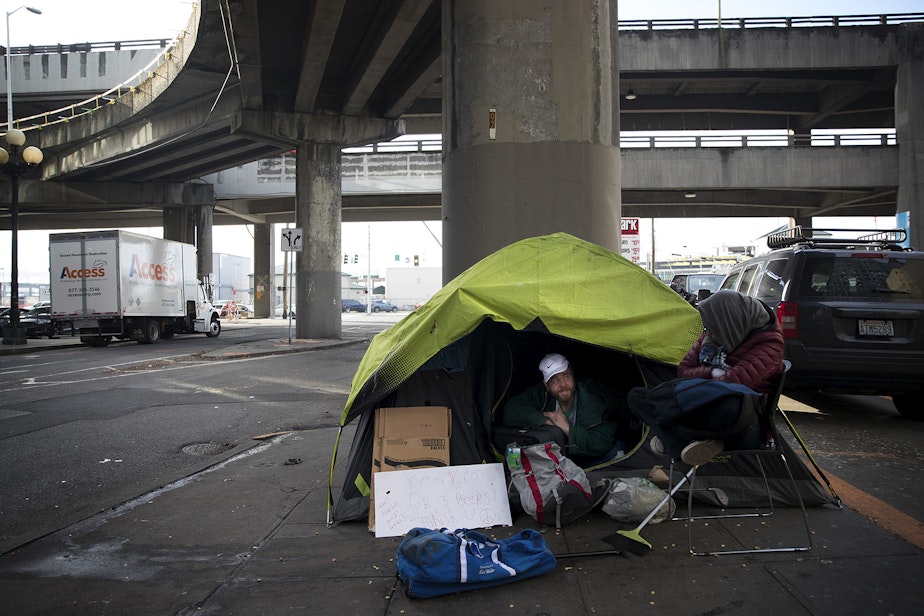Fewer people are homeless on Seattle streets, annual one-night count finds

The number of people living on Seattle’s streets has gone down.
That’s according to the annual one night count of people who are homeless in the region.
Top-line data released earlier this month showed roughly 11,200 people experiencing homelessness were counted across King County on a single night in January.
That’s an 8% decrease from the year before and the first time the yearly count has fallen since 2012.
The full report, released Friday, gives a more comprehensive look at who is homeless and why, and where they are in the county.
In some ways, the data tells a familiar story: People of color continue to be over-represented in the homeless population and thousands of people remain without a stable place to sleep at night.
Sponsored
But this year has also brought some surprises, including a decrease in the number of people counted on Seattle’s streets. That seems at odds with what business and neighborhood groups in places like Sodo and Ballard say they're experiencing.
The annual count is a snapshot, not a comprehensive look at one of the region’s top issues. Officials acknowledge it is very likely an undercount. Year-round data indicates the crisis is much larger.
For years however the results of the tally — which includes people who are living unsheltered in places like tents, vehicles and on the streets, as well as those in shelters and transitional housing — have been used as one measure to gauge the effectiveness of the city and county response.
The numbers show Seattle saw a dip in the overall homeless population between January 2018 and January 2019.
That’s thanks to a decline of more than 20% in the number of people counted living on the streets. That unsheltered population fell to 3,558 people.
Sponsored
An additional 4,239 people in the city were counted in shelters and transitional housing units, a slight increase over last year.
This year’s data comes as frustration over the visible crisis in Seattle has reached new levels.
City of Seattle spokesperson Meg Olberding said there’s no doubt that people are seeing homelessness in their neighborhoods.
“There continues to be a larger number of people falling into homelessness than exiting it,” Olberding said in an email.
But she said she hopes these new numbers show the public that small inroads are being made.
Sponsored
More people are getting services and the number of people being placed in permanent housing continues to increase each year, officials say. Declines in veteran homelessness and in the number of unaccompanied young people who are homeless indicate programs targeting those populations may be working.
Yet the needs continue to outweigh the resources.
“This count is not our only indicator for success,” said Kira Zylstra, acting director of All Home King County, the group that runs the annual count.
“We are in no position to slow down and celebrate,” she wrote in an email.
While this year’s tally showed an overall decrease in the number of people who are homeless and living outside in King County, it also showed shifts in that population.
Sponsored
The number of people living in unsanctioned encampments went up by 32% over 2018.
At the same time, there was a 36% drop in the number of people living in cars, vans and RVs.
That represents a dramatic change from the one-night count last year, which showed a big jump in the number of people living in vehicles in King County.
“The unsheltered population appears to be changing, as it did between 2017 and 2018, and we must continue to utilize multiple data sources to better understand these shifts,” Zylstra said.
The one-night count data is supplemented by survey results. The surveys ask detailed questions of about 1,100 people who are experiencing homelessness. This is self-reported data with a 2.7% margin of error. Here’s a look at what this year’s survey results tell us.
Sponsored
Who is homeless?
This year’s results showed 53% of survey respondents in the county identified as male, 38% identified as female, 3% identified as transgender and 5% identified with another gender.
As in years past, data suggests members of the LGBTQ community experience homelessness at higher rates.
The same holds true for people of color. The majority of people experiencing homelessness in the region are people of color, with the largest disparities seen in the black or African American community and the American Indian community. This year’s data showed increases in both communities, while the percentage of survey respondents identifying as white decreased.
Why are people homeless?
Similar to last year, survey respondents reported loss of a job (24%), alcohol or drug use (16%), and eviction (15%) as the top three primary reasons that led to them experiencing homelessness.
Other self-reported causes of homelessness include inability to afford rent increase (8%), incarceration (6%) and domestic violence (6%).
Where were people before they became homeless?
Also in line with past results, more than 80% of people reported living in King County prior to becoming homeless, while 5% reported living out of state.
About 70% of the people experiencing homelessness on the night of the count were residing in Seattle.
What would help?
The vast majority of survey respondents (75%) indicated that rental assistance and more affordable housing would help them get into permanent housing.
Employment or increased income, and money for moving costs, were also high on the list of things that people said would help.




